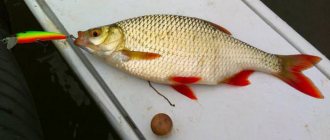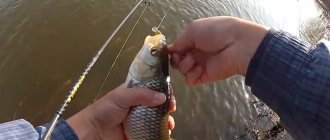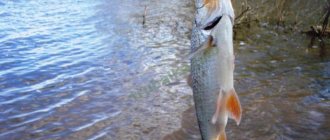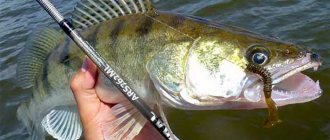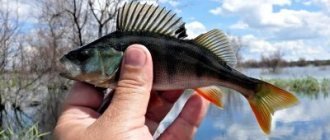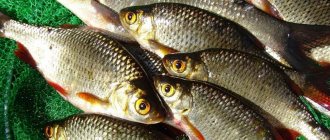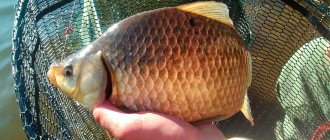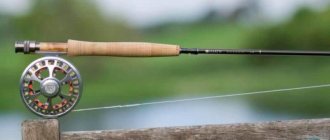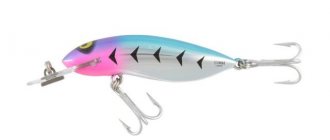From the history..
Once I was returning from the river in a not very good mood - I caught very little. I met a fisherman I knew who was returning from a nearby oxbow lake, and he showed off his trophies - about a dozen selected rudd weighing 300-500 g each. My surprise knew no bounds! The successful fisherman sincerely, without any concealment, shared his experience; it seemed like he hadn’t discovered anything new, but it was very convincing when everything was put together, and with real confirmation.
Since then, catching rudd has seriously interested and fascinated me; I devote a lot of time to it on river oxbows and bays. I fish in a wade or from a boat. I use the first method when I specifically go after this fish. The second - in parallel with the mugs, I arrange the pike tackle and, waiting for the predator to bite, I have fun while away the time with the golden beauty.
Lures for rudd
As bait, I mainly use all kinds of aquatic life: shitika, brown leech, various kinds of larvae caught in algae. A very convenient container for shitik is a tin coffee can, in which I made many holes on all sides with a thin drill. I also riddled the plastic lid with them. I tied a cord, with which I attach the can to the belt of the waders or to the boat. This “house” for caddis flies is constantly in the water and perfectly preserves this delicate bait. If necessary, I lifted it, the water poured out, opened the lid, took out the larva, closed it, and threw it away. Due to the holes, water quickly filled up again and the jar sank.
Fishing with popla popper
Date: May 7, 2021 | 178
There are very ordinary, traditional methods of fishing, and there are very unusual, strange, but, at the same time, effective in their time and under appropriate conditions. One of these extraordinary fishing methods is fishing with a pop-popper. Since soft silicone baits are used here, this gear and the features of its use will be discussed in this review.
Popla-popper is a hybrid spinning rod rig. It is based on a device that combines the properties of a float and a spinning bait such as a popper. There is no hook on the pop-popper itself, but a leash made of thin fluorocarbon or fishing line is attached to it. A small single hook is tied to the end of the leash. A small twister, a silicone worm, a silicone larva, an imitation of maggot, in general, almost any small silicone is attached to it. Naturally, it is best to use edible silicone impregnated with an attractant. It is also possible to use live animal baits.
Popla poppers catch a wide variety of fish. Basically, the objects of such fishing are:
- rudd;
- perch;
- small pike;
- chub;
- asp;
- trout.
Catching rudd with popla popper
In summer, in hot weather, on bays and oxbow lakes, on lakes, large rudd stays in the upper and middle layers of water, near aquatic vegetation, at the edges of water lilies. This is where the pop-popper setup comes in handy. This device will allow us to throw the tackle far; attract rudd from afar (with a popper squelch), and also, place a miniature bait resembling a worm, larva or insect, near the surface or into the floor of the water.
Of course, it is more convenient to fish from a small inflatable boat. It glides perfectly through the algae, and if it frightens the fish, it is only when it gets very close. The craft allows you to stand and cast as best you can, not as you have to. But sometimes situations arise in small bays where it is quite possible to fish from the shore.
So, we attached a pop-popper with a leash to our light spinning rod. We throw it out the window among the algae, or on the edge of the water lilies. We carry it out like a regular popper, in short jerks. We make fairly long pauses, during which the bait slowly sinks under the weight of the hook. It is during pauses that large rudd most often attack.
Of course, as mentioned above, not only rudd bite on a rig with a pop-popper. Perches are fun to bite on this tackle. You come across chub, asp, pike and other fish that are no strangers to staying near the surface and in the middle layers of water.
DIY popla popper
Since the equipment is primitive, you can make it yourself. In the end, sets with mini poppers are not always on sale. The basic float size is 25mm, weight 2.5-3g. At home, you can cut a blank from a dry twig, a thick fragment of pine bark, or hard foam; the thickened part is beveled at a slight angle, literally 5-10 degrees from the straight end cut. The recess in the bow is also selected with a knife or a rounded chisel, if available. Well, they polish the recess by wrapping sandpaper around the rounded end of the stick.
An axial hole is made in the workpiece with an awl or a thin drill. The frame is bent from copper or steel wire. The wire axle is primitive. Just two loops at the ends. A spinning line is attached to the front one, in the nose. To the back is a leash with bait.
It is necessary to load the lower part so that the bait occupies the correct position in the water. To do this, make a longitudinal cut or drill a hole. Either a strip of lead or a shot is pressed into it. Tests can be carried out at this stage, for example in a bathtub or in shallow water. It is necessary to find out whether the funnel creates gurgling noise when jerking the wiring. Then the product is dried if it was made of wood.
Categories: Fishing for food · Tags: Rudd, Maggot, Popper, Silicone
Caution of the rudd
I always take into account the increased caution of large rudd. I fish in a wade and go into the water above my waist so as not to rise too much above the water. When I sit in a boat, I sit at the very bottom, trying to loom less high above the sides of the vessel. I approach (swim up) to a promising place that catches my eye as quietly and carefully as possible. I caught one, which means there are still some, because the rudd is a schooling fish, and the smaller the individuals, the larger the school. In such shoals, the fish remain approximately the same size, and when I run into small things, I usually immediately change the place.
Advantages of catching rudd with a float rod
The advantages of float tackle have long been known, as for its advantages when catching rudd, these are:
- fishing at all levels of the reservoir;
- using the most catchy baits;
- stealth of gear;
- no noise during casting;
- delicate playing;
- fishing of the entire sector.
Rudd prefers to stay close to the shore, so the tackle is not cast far to catch it. Thickets of reeds and tree branches hanging over the water are places where rudd stay in spring, summer and autumn. Only if the wind rises does the fish prefer to go deeper and the angler must take this into account.
It is unwise to catch rudd using bottom fishing rods; they are designed more for trophy fish. But if you make the depth of the float gear greater, this will allow you to fish bottom areas and find fish, provoking them to bite.
The choice of location depends on weather conditions, features of the reservoir and its coastline. The maneuverability of the float equipment allows, if necessary, to quickly move to a more promising place and thereby increase the chances of a successful fishing result.
Lure
I don’t use bait - small things immediately gather in clouds. Of course, a reputable fish can catch up with this fuss, but this circumstance does not bother the small fish - it continues to snatch the caddisfly from under the noses of its older brothers. Large fish can approach in a fairly dense school, then the small ones don’t bother you, but you can’t catch them with bait for a long time – just one or two, and then there’s silence. I’ll wait a few minutes, observing complete silence and the rules of camouflage, and then I’ll drop it again. With this tactic, after catching one specimen, the flock does not leave, and it is possible to take several more tails. But after landing three or four specimens in a row, the rudd usually goes to another place. This means that I need to move around and search again - fishing for rudd almost always involves constant movements near the grass.
What to feed?
The success of fishing largely depends on the right location, bait and bait.
The importance of the latter cannot be underestimated, since it helps to accustom the fish to a certain place and even time of day, and to activate the bite
A universal bait can be considered crackers, pre-fried in vegetable oil, preferably unrefined.
The crackers, along with pieces of macadamia, can be placed in a vegetable net and cast on a fishing line to the intended fishing spot.
Such bait will float in a certain place, create food turbidity around itself, attracting fish.
Another option is feeding with small cakes based on cereals or grains. Usually this is pearl barley, millet, to which ground seeds or hemp seeds, flavorings, bite activators and various dusting ingredients are added.
As the latter, you can use breadcrumbs, semolina, ground cookies, and flour. Some fishermen also add crushed worms, maggots, and insects.
Here it is important not to overdo it and not to overfeed the fish, but only to attract it and preferably awaken the appetite. For this, there are attractants that can be purchased at a fishing store or prepared yourself
Animal origin
It is recommended to add a little bit of bait to the bait that you plan to fish with.
It can be divided into two types:
- animal origin;
- vegetable;
The first includes worms, maggots, dragonflies, grasshoppers, crayfish, and bloodworms. Animal bait is used more in winter, spring and autumn. For bait, they are crushed and added to the main mass. Some fishermen prepare insects by drying them and grinding them into flour.
Vegetable origin
In summer, rudd prefers plant food. One of the favorites is green algae, which is found in abundance on the underwater part of reeds and various structures. Also, fish bite well on porridge, especially semolina, pearl barley or wheat, bread, dough.
Where to look for rudd
Large specimens rarely come out into open water; they stay along the edges of small windows or even in the thicket itself, where every cast of the fishing rod threatens with a dead hook. But if you hit it right, then get ready to grab a real red-feathered mother! When casting into thickets, I set the minimum float descent - about 15 cm.
Often large fish stay along the edge of the cane. Here I try to get the bait exactly between the stems. It is very good if the shitik lies on a water lily leaf, under which large rudd are quite common! I wait a few seconds and slowly pull the equipment from the sheet into the window - the bite follows at the first centimeters of movement of the nozzle in the water column. In any case, at each place I’ll figure out which point is better to cast from, where to land the fish - in the grass I try to avoid offensive hooks.
Another important point: rain and wind ripples on the surface of the water in the hot summer revive the bite of almost all fish, but for some reason only not the large rudd - it does not like these disturbances.
Biting calendar by season
You can catch the river beauty throughout the year, except for the spawning period, when there is a ban. In winter, the best bite is observed on the first ice and before the ice melts.
In spring there are several periods of active “zhora”. The first is immediately after the ice melts. The second is when the water temperature reaches 16-17°C - somewhere in the middle - end of April.
The strongest bite of rudd is observed immediately after spawning - late May - early June. In summer, fish are caught with varying success. The bite worsens before the weather changes (deterioration) and becomes more active before it improves. During periods of extreme heat, successful fishing occurs only in the morning and evening dawn.
In autumn, the bite becomes more intense and can last throughout the day. This is due to the fact that the fish fattens up for the winter and therefore feeds more intensively.
Mach or telescope?
Previously, the tackle was based on a telescopic composite rod with rings and a reel. Then I purchased and tested a five-meter “coal” fly rod on a rudd. Both of these rods have their advantages and disadvantages. A fishing rod with rings is noticeably heavier, a fly rod is lighter and more mobile. However, if it gets caught in the grass, it is easier to release the rig when there is a reel. In the first option, you can reel in the fishing line, stretching it in one line with the fishing rod, pull it towards yourself - the hook is released, or the leash breaks. In the second, I will increase the length of the fishing line and pull it, holding it with my hand. All these manipulations can be performed almost silently, and without the risk of breaking the tip of the rod. With a fly rod and blind equipment, everything is somewhat more complicated; when hooked, I approach a treacherous place and manually unhook the captured hook. For the same reason, I don’t use a leash - equipment without complications is more reliable. I know that some experienced fishermen who fish in wades use this technique when making hooks. The fly rod is placed on the water, pulled back a little, and by smoothly pulling the fishing line, the hook is released or the leash is broken. During these manipulations, water may get inside the rod, so an easily removable butt plug is used. Having removed it, the water is drained and the plug is installed in its original place.
Rigging for rudd
The main line is usually 0.14-0.16. On a running rig I use a slightly thinner leader. There are two rubber stoppers on the line, and between them a small swivel with a carabiner moves freely, to which I attach the float. I make it from dense foam in the shape of a small droplet 1.5-2 cm long and about 1 cm in diameter in the thick part. The float is not brightly colored, it is better to camouflage it properly - fishing is short (10 meters), and for an angler with more or less normal vision It will not be difficult to observe the float in camouflage coloring, which has a positive effect on the process. I glue a small plastic or metal ring into the lower narrow part of the float, onto which a carabiner is fastened. Thanks to the swivel and carabiner, the float is lightly loaded, which is enough for casting.
For the fly tackle, I made the simplest but effective equipment: using a needle, piercing it through, I put a small round cork float on the fishing line, supported it from below with a rubber stopper so that it would not slip when hooking, tied a hook - ready. I don’t use any weights in the rig; the bait sinks slowly. The weight of the equipment is small, but sufficient for casting in calm weather or downwind. I set the depth according to the location - from 15 to 50 cm. I use hook No. 3.5-4 (according to the recommended class).
When and where to catch rudd
Rudd does not like currents, so you should always look for it in low-flowing ponds, lakes, oxbow lakes and backwaters. Throughout the warm season, when the water is freed from the shackles of ice, you should look for rudd in shallow water, in thickets of algae and reeds. Often fills windows between thickets of aquatic vegetation. In one such window you can catch more than a dozen of this fish.
Rudd is caught exclusively during daylight hours. It bites throughout the day, without taking a break even at lunchtime. Like the bite of any other fish, the bite of the rudd becomes more active in the morning and evening dawns. Morning dawn is the most catchy period of time when catching rudd.
The rudd collects fallen butterflies and various mosquitoes from the surface of the water, which often reveals its presence. You can often notice how a bug that has fallen into the water is immediately grabbed by “someone” from under the water; one can easily assume that it was a rudd.
Sometimes rudds reveal themselves in the evenings when they grab flying insects from the surface of the water. You can see how their golden sides sparkle, which means it’s clear where you should stop with your fishing rod. From under the wide belt of reeds, rudd are best caught from a boat. I anchor about 15m from the reed beds and cast my baits 1m to the first stems.
The combination of red corn with strawberry flavor (from Pescaviva) and yellow maggots also worked well. Another bait I trust when catching rudd is breadcrumb pieces. The bread crumb is unsurpassed on ponds where passers-by constantly feed the ducks. There is enough bread left for the fish, and they have become accustomed to this extra food.
Catching baits
Since rudd are fish that readily take food from the surface, they can be caught using drifting bread crumbs. It is best to throw a few pieces of bread crumb into the water before fishing while walking along the shore of the reservoir to see if the rudd are interested in the bait.
[THERE IS AN ANSWER] How to catch rudd in winter using a jig
If you are interested, use a hook with an attachment made from a piece of bread crumb. A carp controller serves as a casting weight. Rudds swallow midges and other insects from the water surface. Therefore, it would be good to try to catch these “gold bars” with grasshoppers. A water ball will provide the necessary mass for casting here.
Floating baits
When fishing for rudd, the bait should sink very slowly. Therefore, it should be given a little buoyancy. This is best done using artificial maggots, artificial bread and foam rubber. You will need a buoyant body that will allow the bait to float only slowly and balance the mass of the hook.
Critically balanced (balanced almost to neutral buoyancy) is what the British call this bait. So, the hook must sink as slowly as the portions of loose bait, otherwise the rudd will become suspicious. When it comes to making baits buoyant, your imagination knows no bounds. You can take a piece of foam from Ohropax earplugs, plastic maggot or caster (Balzer), a piece of artificial bread crumb (Enterprise Tackle) or foam rubber of various colors.
Most often, buoyancy is adjusted using scissors so that the bait really slowly sinks to the bottom. It is advisable to check in shallow coastal waters whether the desired effect is actually achieved. Floating bait near the float rarely brings bites.
Rudd on a fishing rod in overgrown places - classic fishing
The rudd is very numerous, inhabits many reservoirs that are not poor in oxygen, and is caught by almost all fishermen with a fishing rod. Sometimes it is a passing catch when catching other fish. Sometimes it is caught purposefully, special gear, bait,… are created for catching it. Catching rudd with a fishing rod is interesting and exciting, athletes train on it...
Where and how does the rudd bite?
In open water, active rudd biting begins at the end of April. The fish are caught all day long, and gather very closely in the feeding area.
In large reservoirs with a rich food supply, river mouths, and estuaries, the rudd reaches more or less impressive sizes, and its catches on a float rod can amount to tens of kilograms.
In April - May, rudd are mostly found in shallow water, in places where the water warms up faster. At this time, you need to choose a fishing place with a depth of up to 1 meter, preferably overgrown with “grass”, and it is better to catch rudd from the bottom. In summer, it is preferable to fish at depths of 1 - 2 meters, with the hook placed 0.5 - 1 meter from the ground, although even at this time the rudd can perfectly take not only a floating bait.
Rudd on a fishing rod in overgrown places - classic fishing
The fishing rod should be light
For catching rudd, the most suitable tackle will be a fly rod. It is optimal to choose the following:
- the length of the rod is 5 - 6 meters, and for wading fishing in weeds - 4 - 5 meters,
- main line – 0.1 – 0.12 mm,
- leash – with a diameter of 0.08 mm and a length of 10 cm,
- float with a load capacity of up to 1.0 grams, for long rods and windy weather - up to 2.5 grams,
- loading - 2 - 3 weights, hook - under a bloodworm made of thin wire.
With such a light and elegant float, provided it is loaded correctly (only the antenna should be above the water, and the floating body is completely immersed in the water), the slightest bite will be noticeable.
Coloring the floats and selecting the hook
It is necessary to have floats with different colors of antennas, and use them depending on the lighting and fishing conditions. This greatly reduces visual fatigue and makes fishing a complete relaxation. For example,
- for a dark background of water, a white antenna is good,
- for a background that glares in the sun - black,
- for the wave – red-orange.
The hook is used with a straight tip, made from the thinnest wire. The size of the hook rather depends on the type of bait, because the rudd boldly takes large hooks. For bloodworms No. 20, for worms - No. 15, for a slightly smaller dough - No. 16-17. It is recommended to prepare a set of leashes with hooks at home so that you can quickly adapt to the fishing conditions and the mood of the fish.
Rudd is better caught with bait
Fishing for rudd is usually carried out by feeding the place. You can use store-bought bait, but if you have the time and desire to prepare food at home, you can use this simple recipe:
- 1 part breadcrumbs,
- 1 part ground sunflower cake (or preferably ground roasted seeds),
- 0.5 parts ground oat flakes,
- It’s a good idea to add something dusty and buoyant, at least wheat bran...
You need to add the bait you are using into the bait - bloodworms, chopped worms, pearl barley. It is advisable to flavor the bait; for example, the following flavors work well: strawberry, duchess, coriander, anise. Soil, ground through a sieve and added in small quantities, will change the color of the bait, add turbidity and make the bait more durable.
You can mix the ingredients at home, but you need to moisten the food only with water taken from a reservoir, with a fish-like odor. Bleaching impurities in water are simply unacceptable.
Bait and catch
Various doughs, bread crumbs, bloodworms, worms, and pearl barley work well as attachments. Moreover, it is advisable to use the same flavorings for the test baits that were used to prepare the bait.
[THERE IS AN ANSWER] How to catch rudd in winter in March
To soak bread crumbs, it is better to use water from a pond. To prepare dough and cook various recipes, it is better to use purchased water or water from a spring. Such seemingly trifles have a significant impact on the final catch, and the rudd’s fastidiousness is only apparent.
When fishing, it is very useful to experiment and not settle on one thing. If the bite weakens, try changing the depth and changing baits. It is better to start catching rudd from the bottom, then fish in half the water. It is useful to periodically throw small pinches of food or a few pearl barley into the fishing area. This creates excitement in the school, and the fish takes the bait more confidently. And the rudd will not leave you unattended, and a great mood will come with it.
Constant feeding is a bit of a tedious process. But only a good dose of dusty, dry bait that creates a cloud creates a good stir and the fishing goes on confidently...
You can watch the video “Fishing in the Nizhny Novgorod Region” online in good quality on our website for catching rudd with a float rod in the summer in June on Lake Obukhovo, near the village of Memory of the Paris Commune. Enjoy watching!
You can watch the video “Fishing in the Nizhny Novgorod Region” online in good quality on our website for catching rudd with a float rod in the summer in June on Lake Obukhovo, near the village of Memory of the Paris Commune. Enjoy watching!
Searching for and catching rudd with a float rod in the channels between lakes. In the morning, after feeding the place, we started fishing with a float rod. The bites started right away, but the size of the rudd was not encouraging. After changing many places and giving up bait, we found and began to catch a large rudd.
The equipment must have a leash made of fishing line with a cross-section of 0.12 mm, a hook No. 3-4, with a short fore-end. It is recommended to install the sinker at a distance of 20-25 cm from the hook; if fishing conditions allow, then the distance can be safely increased.
Catching rudd in a wade
The higher the wade, the better, as sometimes you have to go into the water up to your chest. In addition, they are large in size so that you can dress warmly, because even in warm summer water it is difficult to survive in light clothing for more than two hours - then you won’t get caught in a tooth, especially if you fish early in the morning or in the evening. Nowadays it’s not a problem to buy a good wading suit, but as a wader I use a military pontoon suit - I bought it once for an occasion, and it still serves me faithfully. Before getting into it, I put on warm cotton pants, a warm jacket, and soft burkas on my feet; in such clothing you can stay in the water all day. Of course, there are shallow areas on the rivers where it is enough to go into the water up to your knees; here you can get by with ordinary waders. Although there is free cheese only in a mousetrap, such relief of the fishing share is only an appearance. After all, a short entry into the water unmasks the angler and forces him to use a longer cast with all its difficulties when fishing in the grass.
What to use to catch rudd in winter?
Bait for rudd can be of either animal or plant origin. Like some other fish, the rudd very actively grabs everything that is on the hook, so you don’t have to worry that it will knock off, for example, dough from the tackle.
For a more successful catch, you can try using different baits, checking which one the fish bites on more actively. If only small individuals begin to be caught, then it is worth increasing the size of what is on the hook.
These include:
- The larva of the apple moth, obtained from spoiled fruits. The sweetness of this insect attracts fish well. It should be stored in a wooden box next to several pieces of apple.
- Bark beetle larvae.
- The dough will also be good at luring rudd. It is worth remembering that during cooking you should not add a lot of flavors, as some of them can be off-putting.
- A good option during winter fishing is gluten made from semolina. The consistency of the food should be such that it holds well on the hook.
To feed the fish, you can use a wide variety of options, which may include both specially developed mixtures and simple bread crumbs, occasionally thrown into the hole. To attract rudd, some raise silt and other particles present at the bottom.
In this turbidity, the fisherman begins to look for food, and as a result, many individuals accumulate in one place. A simple and proven way to attract is to use plant mixtures that you prepare yourself.
The peculiarity of summer fishing is the use of light baits, because during the heat, rudd rises to the very surface of the water and is accustomed to insects falling from time to time.
In order for the bait to slowly sink into the pond, you need to adjust the fishing rod.
If we are talking about the float version, then a sinker is used, installed close to the float. Because of this, a gradual lowering of the feed occurs.
What to use to catch rudd in June?
In June, after spawning, in all reservoirs where this type of fish is found, a good bite is observed, which depends little on the bait used.
It is worth noting that in some reservoirs it bites on a certain bait, while in others it completely refuses. Because of this, it's worth stocking up on several options and trying them all.
What to use to catch rudd in August?
If you follow all the suggested recommendations and try to experiment while searching for bait, lures, and the most suitable places, then a good catch will be guaranteed.
And here's what you need to know: Fishing with a cicada spinner - choice of gear and fishing technique
I will briefly list the main parameters of a promising fishing area:
- the presence of the “right grass”. Mostly pondweed and holly;
- in the place of fishing there should be a weak but stable current, which enriches the water with oxygen and carries food for the fish;
- depths up to 3 m. The lower limit is practically unimportant - of course, within reasonable limits. In practice, I managed to find places with a depth of about 40 cm, densely overgrown with grass, where large rudd stayed from the beginning of June until the end of September;
- proximity of grass to great depths or dumps. This is where the trophy rudd “falls” when the conditions listed above are unfavorable.
It would seem that there are plenty of places that satisfy these requirements; but everything is far from being as simple as it seems. In my practice, there were many cases when in a promising area, where it seemed there should be good fish, small rudd, chub and other fish of not outstanding size were caught.
The fact is that in the grass, similar to pondweed (unfortunately, I don’t know its exact name), growing in such places, there is not an abundance of insects living on algae, to which large rudd is accustomed.
And closer to August, when the water begins to bloom, this grass, covering a large area of water with thick greenery, emits a rather pungent and unpleasant odor. Such places should be avoided when fishing for rudd using a spinning rod.
A promising-looking point can be occupied by a small chub, adjacent only to asp and perch, but not to seasoned rudd.
Fishing for rudd
When fishing for a nimble rudd, they can be plagued by landings; a good landing net will significantly minimize their number. To store caught fish, I use a cage - a simple fine-mesh net with a tightening neck without any rings or other frills, since I have to move a lot through thick algae, and extra parts in the equipment are an additional hindrance. I put the cage over my shoulder using a cord that tightens the neck and is constantly on its side. The length of the cage and cord allows the catch to be in the water when I stand both knee-deep and waist-deep. I place a small stone at the bottom of the cage to submerge the mesh. If I fish from a boat, I use a traditional cage with rings to provide greater freedom to the caught fish - it stays alive longer.
Learning to catch bream on lakes with a feeder
Catching crucian carp in spring with a feeder
Learning to fish with a grasshopper
